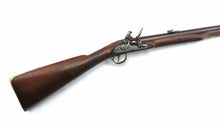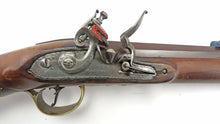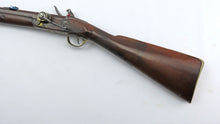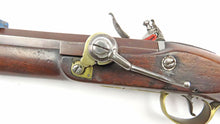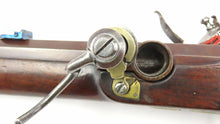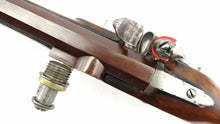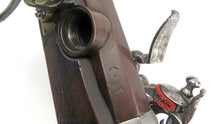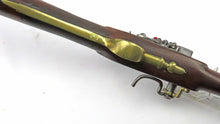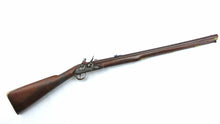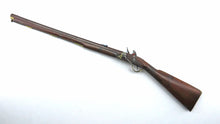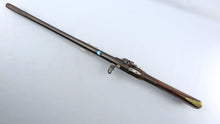
A Very Rare Breech Loading Rifle by John Manton. 44” overall, 29 ½” octagonal carbine bore barrel, with barrel smith’s mark at breech of ''RW'' (William Wilson), & a "PRO" "VED:" Birmingham proof mark. Brass fore sight, two leaf rear sight, the left hand side of breech fitted with an iron screw lever which unscrews to expose the breech aperture and is supported by a paktong bridle, hooked tang, flat, slightly curved border engraved lock signed 'MANTON', French style cock with bun nut, rain proof pan, platinum vent, sliding safe, large roller to the frizzen spring. Walnut fulls tock of quasi-military design with a robust comb-less butt section & a heavy fore stock, nicely checkered wrist. Military style brass furniture comprising trigger guard with acorn finial, musket butt plate, brass nosecap, three iron barrel keys & iron ramrod.
Circa 1805-10
In good condition, barrel refinished, lock of very high quality with some pitting. Good bore, paktong bridal cracked. Possibly made for Ordnance trials or an Officers private purchase.
Made as an improved version of James Wilkes 1801 trials rifle. The system is reminiscent of a side-mounted Ferguson Rifle. James Wilkes' submission in 1801, based on the Baker flintlock rifle, featured a detachable link-retained screwed plug on the left side of the breech, which was considered by The Rifle Corps for trails between 1801 and finally rejected in 1805. See ‘Flintlock Rifles’ by De Witt Bailley page 102-3 for description and photo and H. L. Blackmore's: ‘British Military Firearms’, page. 145
Other unsuccessful British breech loaders included Egg's pattern of c.1788, in which a stout pin running down through the action could be removed to set an automatic safety and allow the chamber to be withdrawn backwards. Hulme's rifle of 1807 had a vertical disc type breech block actuated by a lever on the left side of the barrel.
See ‘The Mantons’ 1782-1879 by D. Black plate 54 for similar lock
James Wilkes, Coventry Street 1796, St James Street 1799-1810, Contractor to Ordnance 1799-1801 (set up Baker Rifles) bankrupt 1802 see H. L. Blackmore's: ‘British Military Firearms’ page 145.
The barrel smiths mark is that of William Wilson who used his father’s RW mark, William Willson & CO, 154 The Minories1772-1810. See H. L. Blackmore's: ‘Gunmakers of London 1350-1850’ page. 204.
John Manton, brother of Joseph, born 1752. Apprenticed to John Dixon, gunsmith, St. Martins Leicester, 1766; to William Edson, gunsmith, Grantham, Lincs, 1768. Served as foreman to J. F. Twigg. Gunsmith 6 Dover St., Piccadilly, 1781-1814. Appointed to Gunmaker in Ordinary to George IV, 1831.











